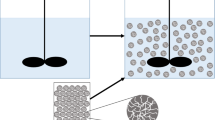Abstract
A study on flocculation control based on fractal theory was carried out. Optimization test of chemical coagulant dosage confirmed that the fractal dimension could reflect the flocculation degree and settling characteristics of aggregates and the good correlation with the turbidity of settled effluent. So that the fractal dimension can be used as the major parameter for flocculation system control and achieve self-acting adjustment of chemical coagulant dosage. The fractal dimension flocculation control system was used for further study carried out on the effects of various flocculation parameters, among which are the dependency relationship among aggregates fractal dimension, chemical coagulant dosage, and turbidity of settled effluent under the conditions of variable water quality and quantity. And basic experimental data were obtained for establishing the chemical coagulant dosage control model mainly based on aggregates fractal dimension.
Similar content being viewed by others
References
Chakraborti, R.K., Gardner, K.H., Atkinson, J.E., van Benschoten, J.E., 2003. Changes in fractal dimension during aggregation.Water Research,37:873–883.
Huang, Y.X., 2005. Simultaneous measurement on particles in solution with size ranging from nm to sub-mm by microscope light scattering spectroscopy and image analyzing system.Current Applied Physics,5(5):549–552.
Kostoglou, M., Konstandopoulos, A.G., 2001. Evolution of aggregate size and fractal dimension during Brownian coagulation.Journal of Aerosol Science,32:1399–1420.
Li, M.Z., Wilkinson, D., 2005. Determination of non-spherical particle size distribution from chord length measurements. Part 1: Theoretical analysis.Chemical Engineering Science,60(12):3251–3265.
Meakin, P., 1988. Models for colloidal aggregation.Ann. Rev. Phys. Chem.,39:237.
Rossi, L., Lubello, C., Poggiali, E., Griffini, O., 2002. Analysis of a clariflocculation process with a photometric dispersion analyzer (PDA 2000).Water Science Technology: Water Supply,2(5–6):57–63.
Swift, J.D., Simic, K., Johnston, R.R.M., Fawell, P.D., Farrow, J.B., 2004. Study of the polymer flocculation reaction in a linear pipe with a focused beam reflectance measurement probe.International Journal of Mineral Processing,73(2–4):103–118.
Tang, S., Preece, J.M., Mcfarlane, C.M., 2000. Fractal morphology and breakage of DLCA and RLCA aggregates.Journal of Colloid and Interface Science,221:114–123.
Thieme, J., Niemeyer, J., 1996. Fractal characterization of hematite aggregates by X-ray microscopy.Geol. Rundsch.,85:852.
Werner, C., Zimmermann, R., Kratzmüller, T., 2001. Streaming potential and streaming current measurements at planar solid/liquid interfaces for simultaneous determination of zeta potential and surface conductivity.Colloids and Surfaces A: Physicochemical and Engineering Aspects,192(1–3):205–213.
Author information
Authors and Affiliations
Additional information
Project (No. 2002AA601120) supported by the Hi-Tech Research and Development Program (863) of China
Rights and permissions
About this article
Cite this article
Ying, C., Qian-jun, L. & Jin-song, Z. Flocculation control study based on fractal theory. J. Zhejiang Univ. Sci. B 6, 1038–1044 (2005). https://doi.org/10.1007/BF02888498
Received:
Accepted:
Issue Date:
DOI: https://doi.org/10.1007/BF02888498




